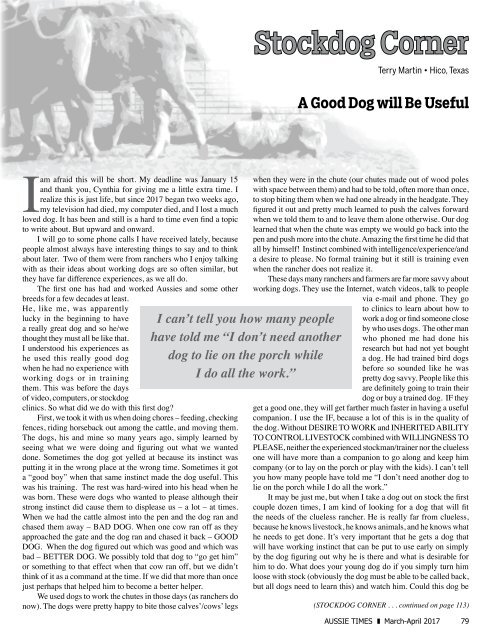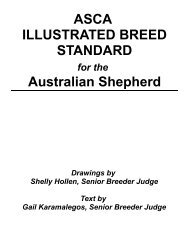Create successful ePaper yourself
Turn your PDF publications into a flip-book with our unique Google optimized e-Paper software.
Stockdog Corner<br />
Terry Martin • Hico, Texas<br />
A Good Dog will Be Useful<br />
I<br />
am afraid this will be short. My deadline was January 15<br />
and thank you, Cynthia for giving me a little extra time. I<br />
realize this is just life, but since <strong>2017</strong> began two weeks ago,<br />
my television had died, my computer died, and I lost a much<br />
loved dog. It has been and still is a hard to time even find a topic<br />
to write about. But upward and onward.<br />
I will go to some phone calls I have received lately, because<br />
people almost always have interesting things to say and to think<br />
about later. Two of them were from ranchers who I enjoy talking<br />
with as their ideas about working dogs are so often similar, but<br />
they have far difference experiences, as we all do.<br />
The first one has had and worked Aussies and some other<br />
breeds for a few decades at least.<br />
He, like me, was apparently<br />
lucky in the beginning to have<br />
a really great dog and so he/we<br />
thought they must all be like that.<br />
I understood his experiences as<br />
he used this really good dog<br />
when he had no experience with<br />
working dogs or in training<br />
them. This was before the days<br />
of video, computers, or stockdog<br />
clinics. So what did we do with this first dog?<br />
First, we took it with us when doing chores – feeding, checking<br />
fences, riding horseback out among the cattle, and moving them.<br />
The dogs, his and mine so many years ago, simply learned by<br />
seeing what we were doing and figuring out what we wanted<br />
done. Sometimes the dog got yelled at because its instinct was<br />
putting it in the wrong place at the wrong time. Sometimes it got<br />
a “good boy” when that same instinct made the dog useful. This<br />
was his training. The rest was hard-wired into his head when he<br />
was born. These were dogs who wanted to please although their<br />
strong instinct did cause them to displease us – a lot – at times.<br />
When we had the cattle almost into the pen and the dog ran and<br />
chased them away – BAD DOG. When one cow ran off as they<br />
approached the gate and the dog ran and chased it back – GOOD<br />
DOG. When the dog figured out which was good and which was<br />
bad – BETTER DOG. We possibly told that dog to “go get him”<br />
or something to that effect when that cow ran off, but we didn’t<br />
think of it as a command at the time. If we did that more than once<br />
just perhaps that helped him to become a better helper.<br />
We used dogs to work the chutes in those days (as ranchers do<br />
now). The dogs were pretty happy to bite those calves’/cows’ legs<br />
I can’t tell you how many people<br />
have told me “I don’t need another<br />
dog to lie on the porch while<br />
I do all the work.”<br />
when they were in the chute (our chutes made out of wood poles<br />
with space between them) and had to be told, often more than once,<br />
to stop biting them when we had one already in the headgate. They<br />
figured it out and pretty much learned to push the calves forward<br />
when we told them to and to leave them alone otherwise. Our dog<br />
learned that when the chute was empty we would go back into the<br />
pen and push more into the chute. Amazing the first time he did that<br />
all by himself! Instinct combined with intelligence/experience/and<br />
a desire to please. No formal training but it still is training even<br />
when the rancher does not realize it.<br />
These days many ranchers and farmers are far more savvy about<br />
working dogs. They use the Internet, watch videos, talk to people<br />
via e-mail and phone. They go<br />
to clinics to learn about how to<br />
work a dog or find someone close<br />
by who uses dogs. The other man<br />
who phoned me had done his<br />
research but had not yet bought<br />
a dog. He had trained bird dogs<br />
before so sounded like he was<br />
pretty dog savvy. People like this<br />
are definitely going to train their<br />
dog or buy a trained dog. IF they<br />
get a good one, they will get farther much faster in having a useful<br />
companion. I use the IF, because a lot of this is in the quality of<br />
the dog. Without DESIRE TO WORK and INHERITED ABILITY<br />
TO CONTROL LIVESTOCK combined with WILLINGNESS TO<br />
PLEASE, neither the experienced stockman/trainer nor the clueless<br />
one will have more than a companion to go along and keep him<br />
company (or to lay on the porch or play with the kids). I can’t tell<br />
you how many people have told me “I don’t need another dog to<br />
lie on the porch while I do all the work.”<br />
It may be just me, but when I take a dog out on stock the first<br />
couple dozen times, I am kind of looking for a dog that will fit<br />
the needs of the clueless rancher. He is really far from clueless,<br />
because he knows livestock, he knows animals, and he knows what<br />
he needs to get done. It’s very important that he gets a dog that<br />
will have working instinct that can be put to use early on simply<br />
by the dog figuring out why he is there and what is desirable for<br />
him to do. What does your young dog do if you simply turn him<br />
loose with stock (obviously the dog must be able to be called back,<br />
but all dogs need to learn this) and watch him. Could this dog be<br />
(STOCKDOG CORNER . . . continued on page 113)<br />
AUSSIE TIMES <strong>March</strong>-<strong>April</strong> <strong>2017</strong> 79



